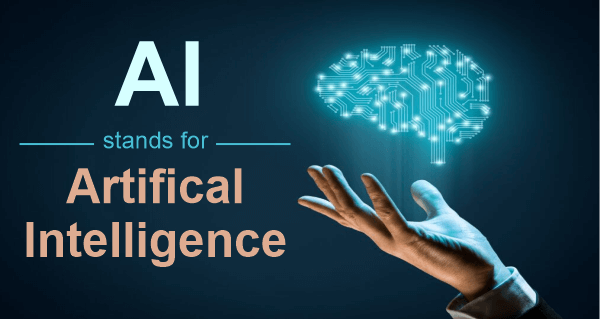What is the full form of AIAI: Artificial IntelligenceAI stands for Artificial Intelligence. There have been several explanations of artificial intelligence (AI) throughout the years, but John McCarthy provides the following description in this 2004 paper: "AI is the science and engineering of creating machine intelligence, particularly intelligent computer programs." AI has a relationship with an analogous goal of utilizing computers to study the intellect of humanity, but AI does not have to constrain itself to biologically observable approaches; years before this definition came into being in 1950, Alan Turing's landmark paper, "Computing Machinery and Intelligence," marked the beginning of the artificial intelligence debate. 
Can machines think? This is the question Turing, who is usually described as the "father of computer science," poses in this essay. Then he proposes a test that has become commonly known as the "Turing Test," in which a human interrogator would attempt to differentiate between a computer-generated and human-written text response. Although this test has been under intense criticism since it was published, it nonetheless contributes significantly to the evolution of AI and continues to be a topic of discussion in philosophy because it uses linguistic concepts. After that, Stuart Russell and Peter Norvig published books on Artificial Intelligence: A Modern Approach, becoming one of the most influential books on the subject. In it, they explore four potential objectives or definitions of AI, differentiating between computer systems based on their reasoning and thinking vs. acting. Human Perspective
Ideal Strategy
Systems that behave like humans would fall under Alan Turing's notion of computers. In its simplest form, artificial intelligence is a topic that combines computer science with big datasets to assist in problem-solving. Additionally, it includes the branches of artificial intelligence known as Deep learning and Machine Learning, which are commonly addressed together. These fields use AI algorithms to build expert systems that make predictions or categorize information based on incoming data. The development of artificial intelligence is still the subject of considerable hype, as is the case with all newly introduced technologies. As mentioned in Gartner's hype cycle, product breakthroughs like autonomous cars and personal assistants follow "a normal evolution of breakthrough, from overenthusiasm to a phase of disillusionment to an ultimate grasp of the innovation's relevance and position in a market or domain." In his MIT talk in 2019, Lex Fridman noted that we were at the pinnacle of inflated expectations and on the verge of disillusionment. Forms of AI (Weak AI vs. Strong AI)Artificial Narrow Intelligence (ANI), also called Weak AI or Narrow AI, is AI that has been programmed and directed to carry out particular tasks. The majority of the AI that exists today is weak AI. This form of AI is anything but weak; it supports some incredibly sophisticated applications, including Amazon's Alexa, IBM Watson, Apple's Siri, and autonomous vehicles. "Narrow" could be a better term for it. The two elements of strong AI are artificial general intelligence (AGI) and artificial super intelligence (ASI). A computer with an intellect comparable to humans, a self-aware awareness, and the capacity to learn, reason, and make plans for the future would be said to have artificial general intelligence (AGI), also known as general AI. Artificial Super Intelligence (ASI) would be more intelligent and capable than the human brain. Even though there are now no real-world applications for strong AI, and it is only theoretical, experts in the field of artificial intelligence are continuously studying its potential. Until then, science fiction works like 2001: A Space Odyssey's HAL, the superhuman, rogue computer helper, may provide the best instances of ASI. Application of Artificial IntelligenceIn the modern world, AI systems are used for various purposes. Among the most common examples are given below: Speech Recognition: This capability employs natural language processing (NLP) to convert spoken words into written ones. It is sometimes referred to as speech-to-text, computer speech recognition, or automatic speech recognition (ASR). Speech recognition is a feature that many mobile devices' operating systems have incorporated to make messaging more accessible and facilitate voice search (like Siri). Consumer Service: Online chatbots are replacing human employees throughout the customer experience. The way we perceive user engagement on websites and social media has changed due to their personalized advice and responses to frequently asked questions (FAQs) about shipping, cross-selling products, and user-size recommendations. Message bots on e-commerce websites equipped with virtual agents, chat apps like Facebook Messenger and Slack, and tasks frequently performed by virtual personal assistants and voice-activated assistants are a few examples. Computer Vision: This area of artificial intelligence (AI) enables systems to recognize relevant information in digital images, videos, and other visual inputs and respond appropriately. Deep neural network-based computer vision is employed in the automotive industry for self-driving vehicles, in healthcare for radiological imaging, and social media for photo tagging because it can offer recommendations; it varies from photo recognition tasks. Recommendation Engines: By analyzing data on prior consumer behaviour, AI algorithms can assist in identifying data patterns that can be applied to create more successful cross-selling tactics. Online stores use this to recommend relevant add-ons to customers during the checkout process. Automation in Stock Trading: High-frequency trading platforms driven by artificial intelligence (AI) carry out dozens, if not millions, of deals each day without a human trader's assistance with optimizing stock portfolios.
Next TopicFull Form
|
 For Videos Join Our Youtube Channel: Join Now
For Videos Join Our Youtube Channel: Join Now
Feedback
- Send your Feedback to [email protected]
Help Others, Please Share










